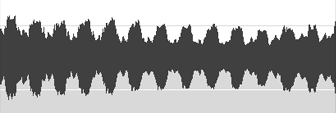Vibrato/Tremolo
The primary contributers to the quality or timbre of the sound of a musical instrument are harmonic content, attack and decay, and vibrato/tremolo. The ordinary definition of vibrato is "periodic changes in the pitch of the tone", and the term tremolo is used to indicate periodic changes in the amplitude or loudness of the tone. So vibrato could be called FM (frequency modulation) and tremolo could be called AM (amplitude modulation) of the tone. Actually, in the voice or the sound of a musical instrument both are usually present to some extent.
Vibrato is considered to be a desirable characteristic of the human voice if it is not excessive. It can be used for expression and adds a richness to the voice. If the harmonic content of a sustained sound from a voice or wind instrument is reproduced precisely, the ear can readily detect the difference in timbre because of the absence of vibrato. More realistic synthesized tones will add some type of vibrato and/or tremolo to produce a more realistic tone.

Above is an amplitude plot of a sustained "ee" vowel sound produced by a female voice. The periodic amplitude change would be described as tremolo by the ordinary definition of it. You could also hear pitch variation along with it, so vibrato was present as well. That is commonly the case. The period of the amplitude modulation is about 0.17 seconds, or a modulation frequency of about 5.8 Hz superimposed on a tone of frequency centered at about 395 Hz. Rough frequency measurements gave frequencies of 392 Hz when the amplitude was high and 399 Hz when the amplitude was low. It is not known whether or not this kind of variation is typical. Scaling the amplitude variation gives a range of about 7 dB in intensity associated with the amplitude modulation.
In his "The Acoustical Foundations of Music", Ch 11, John Backus comments that voice measurements have shown a pitch variation of a singing voice some six to seven times per second usually accompanied by an amplitude variation at the same rate. He references Sacerdote.
The comments of Berg and Stork in their book "The Physics of Sound", 2nd ed, are very close to what I would conclude from my experience and reading. "The vibrato of a singer's voice, for example, aids significantly in distinguishing the voice from other musical sounds. The term 'vibrato' in general use refers not only to periodic changes in pitch, but also to periodic changes in amplitude, which should more correctly be called tremolo. The 'diaphragm vibrato' of a flute player is close to pure tremolo; the vibrato obtained when a trombone player wiggles the slide in and out is almost a pure pitch vibrato. Singing vibrato is actually a mixture of true vibrato and tremolo. Vibrato on a violin or other string instrument is close to pure pitch vibrato."
|
Index
Hearing concepts
References
Rossing, Science of Sound
Backus
Zwicker, et al.
Sacerdote |



